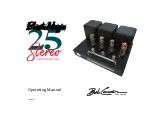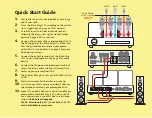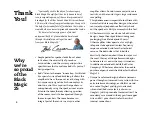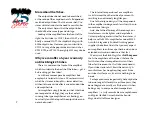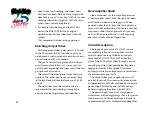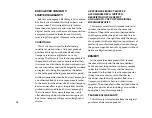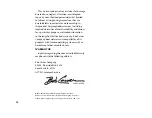
10
control (located on the rear of the
amplifier) for 100 mA, after the
unit has warmed up for about 20
minutes. The normal range to use is
from 60 mA to 120 mA, and changes
here will vary the damping factor of
the amplifier slightly. More current
increases the damping factor, whereas less cur-
rent provides a softer more tube-like sound.
The design center is 100 mA, and that should be
your starting point if you want to experiment.
It will vary from speaker to speaker, and most
importantly with your taste.
The meter reads the combined current for all
four output tubes, and it is normal for this current
to vary slightly with changes in power line voltage.
Tube Substitution
The output tubes do not need to be matched,
as the sound of the amp does not at all depend
on matched output tubes. That’s because the
DC restorer circuit eliminates the need to match
tubes. The only caveat here is that the output
tubes should all be the same type and vintage.
Looking at the amplifier from the front, from left
to right: the first tube is a 12AT7, then a 12AX7, and
finally a second 12AT7. The output tubes are EL-34.
Any of the popular derivatives such as 6550, KT88
or KT120 may also be installed. Bias adjustment
will be required when changing tube types.
Output tubes must always be 4 of the same type.
No mixing.
Monitoring and Tube Troubleshooting.
Once the idling current has been set, it will
normally not need to be adjusted for several years
unless you want to
a) experiment for different
sound;
b) if you install different output tubes, or
c) the amplifier suddenly starts to sound funny.
If you hear a POP and see a flash, yet the amp
continues to play, you should first check the
current and then the output tube fuse.
If the fuse blows, the output current will drop to
zero. If the tube fuse blows, replace it WITHOUT
replacing any tubes.
Turn the amp on and monitor the current. If it
climbs to within the range you had set, and if the
amp sounds good, all is well.
Often, an output tube has a speck of dust-like
impurity, which comes into contact with an
internal element, shorting the element, and is
vaporized into gaseous oblivion. The getter, the
mirror-like shiny plating on the inside of the tube
does its job, absorbs the vaporized material and
the tube is new again. All it takes is a new fuse.
If you install a new fuse and it blows again, you
will need to determine which tube is the culprit.
Proceed as follows:

